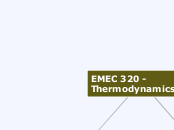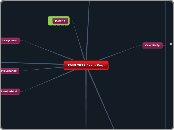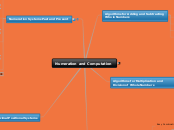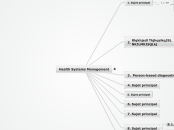Ch. 8
Exergy - an even MORE quantitative way to combine First and Second Laws
Ch. 7
Ch. 6
Ch. 4
Ch. 3
Ch. 2
Ch. 5
Isentropic Efficiencies
--allows you to relate ideal (reversible or isentropic) processes to actual processes using isentropic efficiencies
--actual process is analyzed using actual inlet and outlet conditions
--ideal process is analyzed with actual inlet conditions and outlet conditions are defined by the best possible process
eta_nozzle=actual KE increase/isentropic KE increase
eta_compressor/pump=isentropic work in/actual work in
\eta_turbine=actual work out/isentropic work out
Why would you EVER analyze a system as reversible since that is impossible? Because it is easier. Here is how....
Same things apply for open systems as closed systems for defining terms of the entropy equation.
Isentropic (constant entropy) if adiabatic and reversible
A process is polytropic (n=k=Cp0/Cv0), if ideal gas, adiabatic, and reversible.
Gibbs - a thermodynamic relationship
Gibbs is a relationship between five different thermodynamic properties and is valid for ALL systems,
Tds =du+Pdv
Enthalpy,
\Delta h = \Delta u + Pv
Enthalpy is a made up property that combines three other properties. It is used for convenience
EMEC 320 - Thermodynamics
Conservation of Mass
Open Systems
(Control Volume Approach, Constant Volume)
Transient
Steady
Multiple inlets and exits
Sum(mi)=Sum(me)
One inlet/ one exit
mdoti=mdote
Closed Systems
(Control Mass Approach, Constant Mass)
m1=m2
\Delta m = 0
Second Law of Thermodynamics
Cycles
Refrigerator
Coefficient of Performance
Actual COP,
beta_ref=QL/W
Carnot (ideal) COP,
beta_ref=TL/(TH-TL)
Heat Pump
Coefficient of Performance
Actual COP,
beta_hp=Qh/W
Carnot (ideal) COP,
beta_hp=Th/(Th-TL)
Heat Engine
Thermal Efficiencies
Actual Efficiency,
\eta_he=W/Qh
Carnot (ideal) Efficiency,
\eta_he=1-TL/Th
Entropy Equation
Sum(mdote*se)-Sum(mdoti*si)=\int delta Qdot/T +Sgen
Emptying/Filling a Tank
Single Inlet/Single Exit,
se-si=\int q/T + sgen
Entropy Generation, sgen
Irreversible, sgen is positive
Reversible, sgen=0
Heat Transfer,
\int q/T
Can only calculate if you know how T changes through the device or process.
Adiabatic,
\int q/T=0
Isothermal,
\int q/T = q/T
Entropy change,
calculate the same way as closed systems
Entropy Equation,
S2-S1 = \int delta Q/T + Sgen
Entropy Generation, Sgen
if irreversible,
Sgen>0
Also if irreversible....
(S2-S1)=Q/Tsurr + Sgen (universe)
if reversible,
Sgen=0
Heat transfer, \int delta Q/T
if isothermal,
\int delta Q/T=Q/Tsystem
if adiabatic,
\int delta Q/T=0
Entropy Change, s2-s1
Type of process
Process, s2-s1~=0
Cycle, s2-s1=0
Substance Types
solids and liquids (no phase change),
s2-s1=C*ln(T2/T1)
ideal gas,
(s2-s1)=Cp0*ln(T2/T1)-R*ln(P2/P1)
when phase changes,
use tables
First Law of Thermodynamics
Closed Systems
(Control Mass Approach, Constant Mass)
This is how you analyze systems that have no mass leaving or entering the system.
Examples: piston cylinders, balloons, closed tanks, rigid tanks.
Energy Equation
/Delta E = Q - W
Work, W
Other (usually given or what you are finding)
Chemical
Electrical
Shaft
Boundary Work
When boundary is moving (volume changes through the process), W=\int P dV
Linear,
P=mV+b
Polytropic,
P=C/V^n
Isothermal (constant temperature) and ideal gas,
P=mRT/V
Isobaric, constant pressure
P=C
Heat, Q
Usually this is given or it is what you are finding
Types
Radiation
Convection
Conduction
Total Energy, \Delta E
Internal Energy, \Delta U
If Solid or Liquid (no phase change)
\Delta u=C*\Delta T
If multi phase (water, refrigerant, or ammonia)
Use tables
Superheated Vapor
PTsat
u>ug
v>vg
s>sg
Saturated Vapor
P=Psat
T=Tsat
u=ug
(ditto for v, s, & h)
Saturated Mixture
P=Psat
T=Tsat
u=uf+x*ufg
(ditto for v, s, & h)
Saturated Liquid
P=Psat
T=Tsat
u=uf
(ditto for v, s, & h)
Compressed Liquid
P>Psat
T
If ideal Gas
\Delta u = C_v0*\Delta T
Kinetic Energy, \Delta KE
Potential Energy, \Delta PE
Open Systems
(Control Volume Approach, Constant Volume)
This is how you analyze systems that have mass flowing in or out.
Examples: nozzles, diffusers, pumps, turbines, compressors, heat exchangers, mixing chambers, etc.
Energy Equation,
DEcv/Dt=Qdot-Wdot+Sum_e(mdot*(h+ke+pe))-Sum_i(mdot*(h+ke+pe))
Transient Systems
Filling or Emptying a Tank
Steady Systems
Multiple Inlets/Exits
Mixing Chambers
Heat Exchanger
Single Inlet/Single Exit
q+h_i+ke_i+pe_i=w+h_e+ke_e+pe_e
Pipes/Ducts
Heater/Cooler/Boiler
Pumps
Compressors/Fans
Turbines/Expanders
Throttling Devices/Valves
Nozzle/Diffuser









